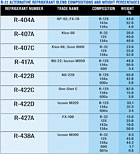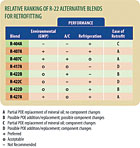
Table 1. Note: R-600 (Butane), R-600a (Isobutane), R601a (Isopentane)
• Air conditioning vs. refrigeration (evaporator temperatures);
• Application of the equipment; and
• Size of the equipment.
Air conditioning vs. refrigeration (evaporator temperatures):Refrigerant retrofit blends will behave differently when exposed to different evaporator temperatures. Some refrigerant blends will closely match R-22 properties for air conditioning evaporating temperatures (35 to 50°F), while others will be better suited for the lower evaporating temperatures of medium- and low-temperature refrigeration applications (20 to -20°).
Application of the equipment:Equipment capacity and run time also influences what refrigerant blend to incorporate in a system. One refrigerant blend may have a lower capacity than another blend. Often, air conditioning systems have an off cycle because of milder temperatures in the local area.
Air conditioning systems are often designed for the hottest days of the year. However, these days are not always realized and the air conditioning system will cycle off. These air conditioning systems can tolerate a lower-capacity blend simply by having longer run or on times. This also holds true for refrigeration storage facilities. However, a problem arises when systems are running all of the time because they are sized to load match, or exactly match the capacity of the load. The solution here is to use a refrigerant blend with a higher capacity in order for the system to run to its peak performance.
Size of the equipment:How easy a system is to retrofit is a major factor in refrigerant retrofit blend selection. Larger refrigeration or air conditioning system retrofitting may need lubricant changes, component replacement, adjustment of controls, and maybe even seal and gasket changes.
This often requires planned shutdowns and will generally be time-consuming and expensive. Choosing a retrofit blend based on performance and property matches that minimize component changes will be more important than ease of retrofit issues such as changing oil. On the other hand, smaller equipment may not have direct access to the oil and may not have discreet parts to change. Retrofit blends that minimize work done during retrofits may be desirable even though performance may suffer. Often, depending on the equipment’s age and condition, simply replacing the entire unit may be a better economic solution with smaller equipment.
The retrofitting chart for R-22 alternative blends (see Figure 1) can be used to assist in choosing the best retrofit blend for the application. Table 1 is a breakdown of certain refrigerants by refrigerant number, trade name, composition, and weight percentages.

FIGURE 1: Retrofitting chart for R-22 alternative blends. (Figure courtesy of National Refrigerants.)
OILS AND LUBRICANTS
The retrofit refrigerant blends listed in Table 1 and Figure 1 are all HFC-based refrigerant blends. Some of these blends contain hydrocarbons (HC) like R-600 (Butane) and R-600a (Isobutane). The small percentages of hydrocarbons help with oil return to the compressor. The hydrocarbons will soak into the mineral oil and thin the oil so it can be more easily returned to the compressor’s crankcase on the low side of the system.However, for larger refrigeration and air conditioning systems with receivers, oil that escapes the compressor will eventually form a layer on top of the liquid refrigerant in the receiver.
These hydrocarbons will not mix with the liquid oil layer in the receiver on the high side. The solution is the addition of some POE lubricant or partial POE replacement of the mineral oil to help dissolve the oil back into the liquid refrigerant in the receiver and keep it in circulation through the refrigeration or air conditioning system. Eventually this lubricant will make it back to the compressor’s crankcase.
In conclusion, there is not one perfect refrigerant blend that will be a perfect drop-in replacement for retrofitting R-22 systems. Each refrigerant blend has advantages and disadvantages. These advantages and disadvantages have to be balanced to choose the best overall choice for your specific application.
Note:Always consult with the compressor manufacturer or follow its specific retrofit guidelines before performing a retrofit on any R-22 system or any other refrigeration system.
The information in this article was acquired from National Refrigerants Inc. Any questions about this article should be addressed to either Jim Lavelle of National Refrigerants Inc. at 800-262-0012, or John Tomczyk at tomczykj@ferris.edu.
Publication date:09/07/2009


Report Abusive Comment